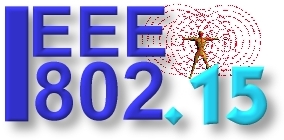

This page will provide links to the candidate Coexistence Mechanism proposals that are contributed to TG2. Again, there are two classes of Coexistence Mechanisms: Collaborative and Non-Collaborative Mechanisms. If it is possible for the WPAN™ and the WLAN to exchange information between one another then it is possible to develop a Collaborative Coexistence Mechanism where the two wireless networks negotiate to minimize mutual interference. If there is no method to exchange information between the two wireless networks then you can use a Non-Collaborative Coexistence Mechanism. Submissions of both types of mechanisms are encouraged. Depending on the operating environment one technique may be preferred over the other.
K. Marquess and N. Golmie, TG2 Coexistence Mechanism Summary Matrix, 01/078r2 [-01/078r2]
N. Golmie, TG2 Submission Matrix, 01/078r0 [01078r0P802-15_TG2-Submission-Matrix.xls]
Steve Shellhammer, Coexistence Mechanism Selection Procedure, 00/353r2 [00353r2P802-15_TG2-Selection-Procedure.ppt]
Session #12/Orlando Update: The Task Group selected -01/252r0 as the Adaptive Frequency Hopping Non-Collaborative Coexistence Mechanism. The Task Group voted to drop the Transmit Power Control in the 802.11 Non-Collaborative Mechanism since it is being handled in 802.11h. There is interest in pursuing the Data Rate Scaling Mechanism if we find resources to work on it.
K.C. Chen, H. K. Chen, C.C. Chao, Merged IPC and TI Adaptive Frequency Hopping Proposals, -01/246r0
Bijan Treister, AFH Ad Hoc Group
Summary,
-01/248r0![]()
B. Treister, H. B. Gan, K. C. Chen, H. K. Chen, A. Batra, O. Eliezer, Adaptive Frequency Hopping: A Non-Collaborative Coexistence Mechanism, -01/252r0
J. Lansford and S. Shellhammer, Collaborative Coexistence Mechanism Submission: Mobilian's META and Symbol's TDMA, -01/164r0
J. Liang, Proposal for a Collaborative BT and 802.11b MAC Mechanism for Enhanced Coexistence, -01/080r1
R. Van Dyck and A. Soltanian, 802.11b Deterministic Frequency Nulling to Mitigate Bluetooth Interference, -01/079r1
H. Gan, Adaptive Frequency Hopping, -00/367r1
J. Liang, Proposal for a Non-Collaborative BT and 802.11b MAC Mechanism for Enhanced Coexistence, -01/026r1
K. C. Chen and H. K. Chen and C. C. Chao, Selective Hopping for Hit Avoidance, -01/057r2
N. Golmie, Interference Aware Bluetooth Scheduling Techniques, -01/143r0
O. Eliezer and D. Michael, Adaptive Frequency Hopping for FHSS Systems, -01/169r0
A. Batra, An Intelligent Frequency Hopping Scheme for Improved Bluetooth Throughput in an Interference-Limited Environment, -01/082r1
K. C. Chen, Selective Hit Avoidance, -01/057r1
K. C. Chen, Selective Hit Avoidance, 01/057r0 [01057r0P802-15_TG2-Selective-Hopping-for-Hit-Avoidance.ppt]
Nada Golmie, Power Control and Packet Scheduling for Bluetooth to Avoid 802.11 Direct Sequence Interference, 01/063r0 [01063r0P802-15_TG2-Power-Control-and-Scheduling-for-BT.ppt]
Steve Shellhammer, Collocated Collaborative Coexistence Mechanism: TDMA of 802.11 and Bluetooth, 01/025r0 [01025r0P802-15_TG2-TDMA-80211-Bluetooth.ppt]
Steve Shellhammer, Miscellaneous Coexistence Ideas, 01/033r0 [01033r0P802-15_TG2-Misc-Coexistence-Ideas.ppt]
Matthew Shoemake, Power Control for Enhanced Coexistence, 01/081r0 [01081r0P802-15_TG2-Power-Control-for-Enhanced-Coexistence.ppt]
A. Batra, J. M. Ho, K. Anim-Appiah, Proposal for Intelligent Bluetooth Frequency Hopping, 01/082r0 [01082r0P802-15_TG2-Intelligent-Frequency-Hopping.ppt]
O. Eliezer, Evaluation of Coexistence Performance, 01/091r1 [01091r1P802-15_TG2-Evaluation-of-Coexistence-Performance.ppt]
B. Van Dyck, 802.11b Deterministic Frequency Nulling, 01/079r0 [01079r0P802-15_TG2-Jan01-NIST-nulling.ppt]
O. Eliezer, Non-Collaborative Mechanisms for Enhance Coexistence, 01/092r1 [01092r1P802-15_TG2-Non-collaborative-Mechanisms-for-FHSS.ppt]
M. Shoemake, Adaptive Fragmentation, 01/083r0 [01083r0P802-15_TG2-Proposal-for-Non-collaborative-802-11-MAC-Mechanisms-for-Enhancing-Coexistence.ppt]
J. Liang, Proposal Non-Collaborative Mechanism for enhancing coexistence, 01/026r0 [01026r0P802-15_TG2-TI-MAC-non-collaborative.ppt]
J. Liang, Proposal for Collaborative Bluetooth and 802.11b MAC Mechanism for Enhanced Coexistence 01/080r0 [01080r0P802-15_TG2-TI_MAC_collaborative.ppt]
Hong Bin Gan, Adaptive Frequency Hopping, 00/367r0 [00367r0P802-15_TG2-Adaptive-Frequency-Hopping.ppt]
Jim Lansford, MEHTA: A Method of Coexistence, 00/360r0 [00360r0P802-15_TG2-Mobilian-coexistence-proposal.ppt]
| If you would like to
contact the IEEE 802.15 Webmaster, email to alfvin@ieee.org © Copyright 2001, IEEE. Terms & Conditions. Privacy & Security |
|
(alfvin@ieee.org)
URL:
http://ieee802.org/15/pub/TG2-Coexistence-Mechanisms.html
(Modified: 05-Feb-2004
), Rev. 0.1